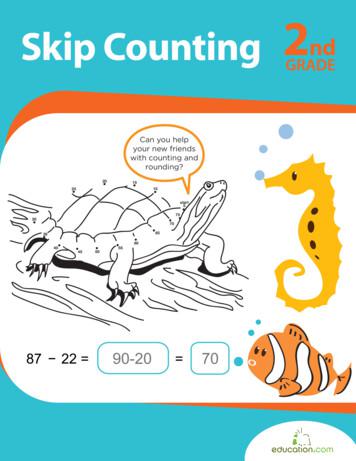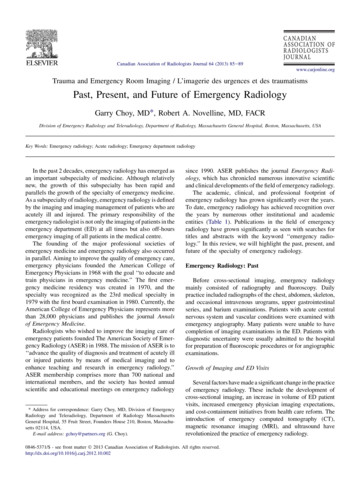Lewis Dot Structures And VSEPR - Surry County Public .
Lewis Dot Structures andMolecular GeometriesDr. Walker
What will you know? What willyou do? (3c) ·Lewis dot diagrams are used to represent valence electrons in anelement. Structural formulas show the arrangements of atoms and bonds in amolecule and are represented by Lewis dot structures.Draw Lewis dot diagrams to represent valence electrons in elements anddraw Lewis dot structures to show covalent bonding.Use valence shell electron pair repulsion (VSEPR) model to draw and namemolecular shapes (bent, linear, trigonal planar, tetrahedral, and trigonalpyramidal).Polar bonds form between elements with very different electronegativities.Non-polar bonds form between elements with similar electronegativities.Polar molecules result when electrons are distributed unequally.Recognize polar molecules and non-polar molecules.(6a) · Draw Lewis dot structures, identify geometries, and describe polaritiesof the following molecules: CH4, C2H6, C2H4, C2H2, CH3CH2OH, CH2O, C6H6,CH3COOH.
Lewis Dot Structures Created by Gilbert Lewis in 1916 Shows structural formulas for compounds– Arrangement of atoms and bonds within acompoundStructural formula forMethane, CH4
Lewis Dot Structures Uses valence electrons One dot one valence electron One dash a covalent bond twoelectrons
Lewis Dot Structureshttp://www.roymech.co.uk/images14/lewis elements.gif
Practice How many dots will the following elementscontain?– Fluorine– Boron– Carbon
Practice How many dots will the following elementscontain?– Fluorine 7– Boron 3– Carbon 4 Equal to number of valence electrons– For main groups, equal to last number of groupnumber
Lewis Structures Lewis structures show how valence electronsare arranged among atoms in a molecule. Lewis structures reflect the idea that stabilityof a compound relates to the octet rule Shared electrons pairs are covalent bonds andcan be represented by two dots (:) or by asingle line ( - )
HONC, HONC. The HONC Rule– Hydrogen (and Halogens) form one covalent bond– Oxygen (and sulfur) form two covalent bonds One double bond, or two single bonds– Nitrogen (and phosphorus) form three covalentbonds One triple bond, or three single bonds, or one double bondand one single bond– Carbon (and silicon) form four covalent bonds. Two double bonds, or four single bonds, or one triple andone single, or one double and two singles
Lewis Dot Structures Compounds Make the atom wanting the most bonds the central atom(if more than 2 total atoms) Draw proper number of dots ( valence electrons aroundeach atom). Join atoms on the outside with the central atom usingelectron pairs, obeying the HONC rule Make sure every atom has a full valence shell (2 e- for H, 8for everything else)– Boron the only exception we’ll cover, he gets 6 valenceelectrons
Additional Note on Octet Rule Atoms in the third row and below candisobey the octet rule at various times.We will not cover those structures in thiscourse. (DE anyone?)– This is for a simplification of material with adegree of honesty.
Examples – On Board H2ONH3BH3CCl4CO2HCNDiatomics
Examples
Carbon Based Molecules With multiple carbon compounds, connectcarbons together Arrange other elements around carbon, filloctets
Carbon Based Molecules Practice (on board)––––C2H6C2H4C2H5OHFormaldehyde (CH2O)
Carbon Based MoleculesEthyneEthaneEtheneFormaldehydeEthanol
Carbon Based MoleculesBenzeneAcetic Acid
Molecular Geometry Based on Valence Shell Electron PairRepulsion (VSEPR) theory Electron pairs around a central atomarrange themselves so they can be as farapart as possible from each other.
Molecular Geometry You will be responsible for five molecular shapes Compounds take a three-dimensional shapebased on:– Number of atoms attached– Number of unbonded electrons present These are general rules for binary compounds– There are always exceptions!!! (includingorganics)
Linear Carbon is central atomSurrounded by two oxygen atomsNo unbonded electrons on carbonLook for AX2 geometry– Central atom is group 14
Bent Oxygen is central atom– Central atom is typically group 16. Surrounded by two atoms (H or halogen) Two unbonded electron pairs on oxygen,push hydrogens out of the plane
Bent vs. LinearWhat’s The Difference?Unbonded electronson oxygenBent Both have a similarformula (AX2) Look at the central atom– If the element is group14, it is linear– If the element is group16, it is bent– Look for presence orabsence of unbondedelectronsNo unbonded electronson carbonLinear
Write allTrigonal Pyramidal Nitrogen surrounded by three hydrogen atoms(or halogens) One pair of unbonded electrons, push hydrogensout of olecshapes4.jpg
rig pyr top.jpg
Trigonal Planar Boron is central atom surrounded by threefluorine atoms (or H or other halogen) Boron can defy octet rule, happy with sixelectrons No unbonded electrons on boron, fluorine atomsstay within a single plane
Planar vs. Pyramidal Both have similar formula (AX3) Look at the central atom– If it has unbonded electrons, itwill be trigonal pyramidal– If it doesn’t have unbondedNo unbondedelectrons (only boron!), it will Electrons on boronbe trigonal planar
Tetrahedral AX4 formula Carbon (or silicon) surrounded by four hydrogens(or halogens) Only shape we’re concerned with foursurrounding atomshttp://www.elmhurst.edu/ chm/vchembook/204tetrahedral.html
DescriptionExampleLinear(AX2)2 outside atoms0 lone pairsCO2Bent (AX2)2 outside atoms2 lone pairsH2Otrigonal planar3 outside atoms0 lone pairsBF3Tetrahedral (AX4)4 outside atoms0 lone pairsCH4trigonal pyramidal(AX3)3 outside atoms1 lone pairNH3Molecular GeometryDiagram(AX3, A boron)
Write allPolarity– Bond Polarity Difference in electronegativitybetween two atoms in a chemicalbond Unequal sharing of electrons between elements
Write allBond Polarity Ionic– Elements on opposite sides of periodic table (metal nonmetal)– Examples NaCl, LiF, ZnCl Polar Covalent (unequal sharing)– Two elements on right side (both nonmetals) of periodictable– C-O, S-O, P-Br Nonpolar covalent (equal sharing)– Two of the same element on the right side of the periodictable– H-H, Cl-Cl, O O
Write allMolecular Polarities Polar molecules occur when electrons are NOTdistributed equally Look for symmetry within molecule– Only one line of symmetry – Polar molecule Polar shapes– Trigonal pyramidal– Bent These rules will apply regardless of the number ofatoms on the molecule with these shapes
Write allMolecular Polarities Nonpolar molecules occur when electrons aredistributed equally Look for symmetry within molecule– More than one line of symmetry – Nonpolar molecule Nonpolar shapes– Linear– Trigonal Planar– Tetrahedral These are just guidelines for binary compounds(two elements). Compounds with multipleelements and organics do not apply to theserules.
Skills to Master Drawing Lewis dot structures from a givenmolecular formula Assigning a shape based on a molecularformula (or Lewis dot structure) Determine whether a bond is polar ornonpolar Determine whether a molecule is polar ornonpolar based on formula (or Lewis dotstructure)
Terms To Know Lewis Dot StructureStructural formulaLinearBentTrigonal pyramidalTrigonal planarTetrahedralPolarityElectronegativity (review)PolarPolar covalentNonpolarNonpolar covalent
(3c) ·Lewis dot diagrams are used to represent valence electrons in an element. Structural formulas show the arrangements of atoms and bonds in a molecule and are represented by Lewis dot structures. Draw Lewis dot diagrams to represent valence electrons in elements and draw Lewis dot structures to show covalent bonding.
Experiment 14 - Lewis Dot Structures & Geometry by VSEPR Theory I. PURPOSE In this exercise we will learn and practice the determination of Lewis dot structures of covalently bonded molecules (and ions) as a tool for predicting or explaining the number of bonds present, the number and location of bonding and non-bonding electrons
Skip Counting Hundreds Chart Skip Counting by 2s, 5s and 10s to 100 Counting to 120 Dot-to-Dot Zoo: Count by 2 #1 Dot-to-Dot Zoo: Tapir Count by 2 Dot-to-Dot Zoo: Antelope Count by 2 Dot-to-Dot Zoo: Count by 2 #2 Dot-to-Dot Zoo: Count by 2 #3 Dot-to-Dot Zoo: Count by 3 Connect the Dots by 5!
The Journals of Lewis and Clark. By Meriwether Lewis and and William Clark, 1804-1806. Note: These Journals are from May 14, 1804, the day the expedition left the Mississippi River, to September 26, 1806, a day or two after they arrived back in St. Louis. It includes all possible Journal entries of Lewis and Clark. Most of the "courses andFile Size: 4MBPage Count: 1023Explore furtherJournal Entries from the Lewis and Clark Expeditionwww.lewisandclarkexhibit.orgThe Journals of Lewis and Clark, by Meriwether Lewis and .www.gutenberg.orgThe Journals of the Lewis & Clark Expedition Center for .www.unl.eduHome Journals of the Lewis and Clark Expeditionlewisandclarkjournals.unl.eduJournal Excerpts Discovering Lewis & Clarklewis-clark.orgRecommended to you b
—Lewis Dot Structures and Molecule Geometries Worksheet 1 Lewis Dot Structures and Molecule Geometries Worksheet How to Draw a Lewis Dot Structure 1. Find the total sum of valence electrons that each atom contributes to the molecule or polyatomic ion. You can quickly refer to the periodic table for the group A number for this information.
Lewis dot diagrams In grade 9, you learned how to represent the atom by using Bohr Diagrams. Since Bohr diagrams can be a bit cumbersome to draw, we can use a shorter, more convenient notation. Lewis Dot Diagrams (Electron Dot Diagrams) A Lewis dot diagram is a way to represent an element and its VALENCE electrons.
dunkin-lewis, inc. horton archery llc 536 dunkin-lewis, inc. lucky craft, inc. 1336 dunkin-lewis, inc. plano inc. fall line 525 dunkin-lewis, inc. plano molding company 1342 dunkin-lewis, inc. tour star products llc 1340 dunkin-lewis, inc. windham weaponry 126 dunkin-lewis, inc. umarex usa 539 dunkin-lewis, inc. walther 130 dunkin-lewis, inc .
left-hand keys contain the following: Dot 1 under the index finger, Dot 2 under the middle finger, dot 3 under the ring finger, and dot 7 under the little finger, while the right-hand contains: Dot 4 under the index finger, Dot 5 under the middle finger, Dot 6 under the ring finger, and Dot 8 under the little finger. These keys are used to .
ABR ¼ American Board of Radiology; ARRS ¼ American Roentgen Ray Society; RSNA ¼ Radiological Society of North America. Table 2 Designing an emergency radiology facility for today Determine location of radiology in the emergency department Review imaging statistics and trends to determine type and volume of examinations in emergency radiology Prepare a comprehensive architectural program .























